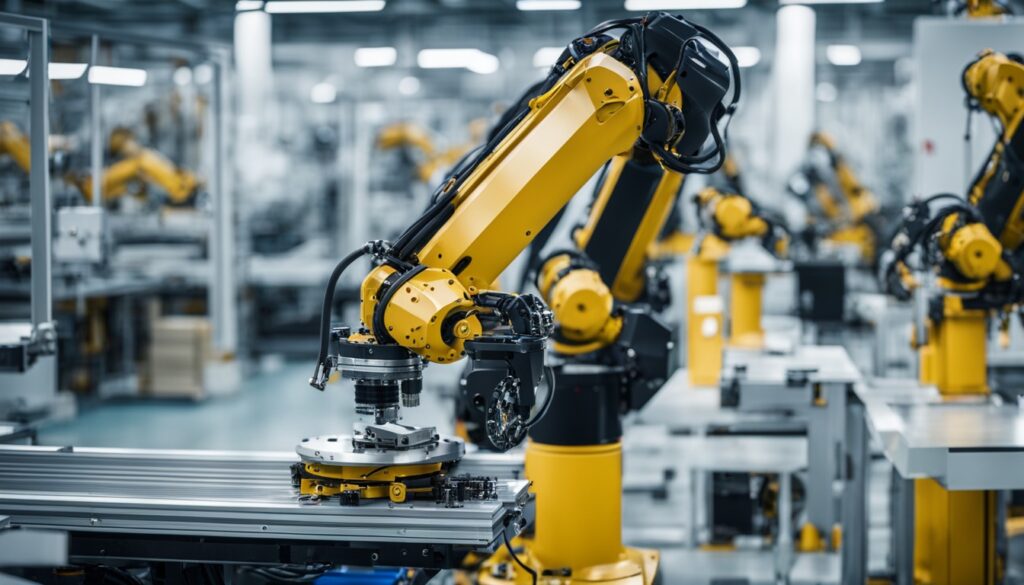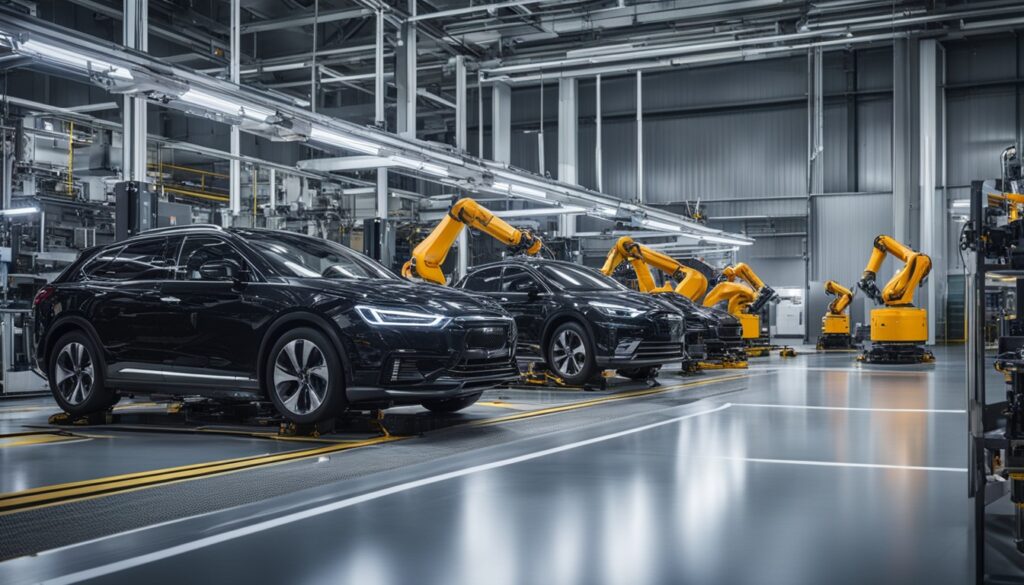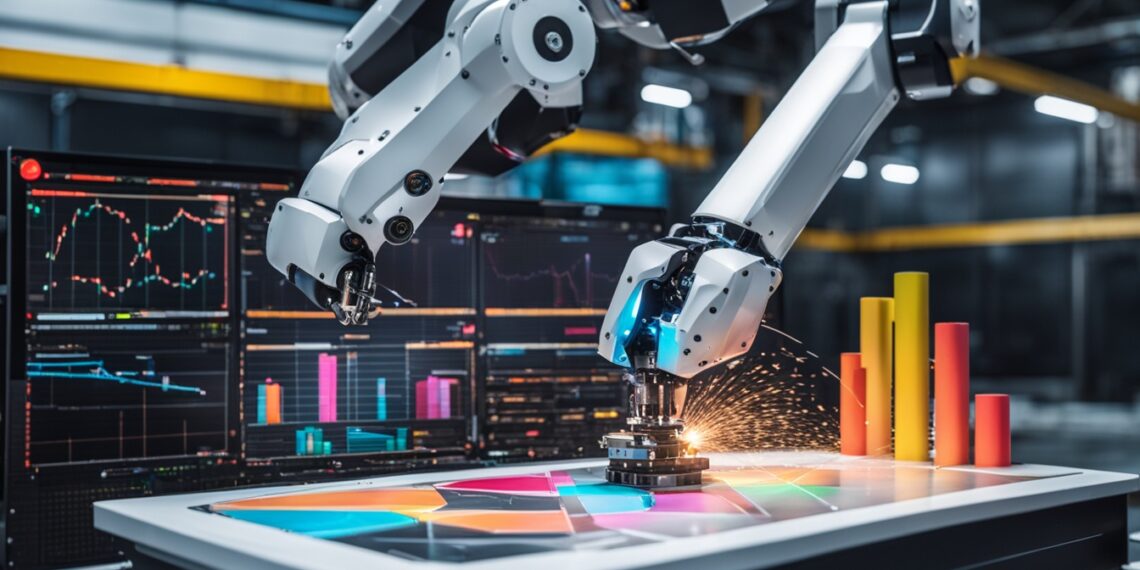Did you know over 70% of industries now use artificial intelligence? We’re at the start of a new era where AI is changing manufacturing. Technologies like machine learning and robotics are making operations more efficient. This change is key for companies to stay ahead in a tough market.
AI in manufacturing boosts productivity by automating tasks that used to take up a lot of time. This lets workers focus on more important tasks. Companies like General Electric and BMW show how AI can cut downtime and improve resource management.
This article will show how AI is bringing new innovations and chances for growth to manufacturing. Let’s dive into how AI is becoming a crucial part of today’s manufacturing world.
Key Takeaways
- Over 70% of industries are using AI in their work, showing its wide adoption.
- AI is key to making manufacturing more efficient and cutting costs.
- Companies see big gains in productivity and quality control with AI.
- AI-driven predictive maintenance cuts downtime and maintenance costs a lot.
- AI in manufacturing is expected to grow to $20.8 billion by 2028, showing a strong future.
The Rise of AI in Manufacturing
The manufacturing world is changing fast with AI. This tech boosts production and helps make better decisions. Companies use AI to make their work faster and smarter. They use data to make things more efficient, making AI key in today’s factories.
Defining Artificial Intelligence in the Manufacturing Sector
AI includes things like machine learning, robotics, and automation. These tools help solve problems in manufacturing. AI makes routine tasks automatic, ensuring everything is done right every time.
It helps companies plan better and manage their stock. They can also meet customer needs more easily.
The Current Landscape of AI Adoption
AI is growing fast in manufacturing because it makes things more efficient and competitive. A survey found 63% of companies want to spend more on AI. The global AI market for manufacturing could hit $20.8 billion by 2028.
Sectors like the automotive, food, and beverage, and aviation are quickly adding AI. This shows how different areas are growing in different ways:
| Industry | Projected Market Size | Growth Rate |
|---|---|---|
| Automotive AI | $7 billion by 2027 | N/A |
| Food and Beverage | $35.42 billion by 2028 | N/A |
| Aviation | $686.4 million in 2022 | CAGR over 20% |
| Overall AI in Manufacturing | $20.8 billion by 2028 | N/A |
As companies go digital, only a third are using AI yet. The future looks like more AI for specific tasks in manufacturing. This will help solve different problems in a smart way.
Advantages of Implementing AI in Manufacturing
Adding AI to manufacturing brings big changes. It makes factories more efficient and improves quality control. Automation helps companies produce more without lowering quality.
Efficiency Gains through Automation
Factories can now make more products, up to 20% more. AI helps keep machines running well, cutting downtime. This means making products faster and getting them to customers quicker.
Cost Savings with AI Integration
Using AI saves money for manufacturers. Maintenance costs can drop by up to 25%. Better managing inventory cuts logistics costs by about 15%, and inventory levels can go down by 35%.
This smart use of resources saves money and makes operations better. For more on AI in manufacturing, check out this link.
Improved Quality Control and Error Reduction
AI makes quality control much better. It uses advanced algorithms and computer vision to spot defects accurately, up to 90%. This leads to a big jump in productivity, up to 50%, while keeping quality high.
AI can find problems that humans miss, offering a strong solution to quality issues.
AI in Manufacturing: Revolutionizing Processes
Artificial Intelligence is changing how we make things, making things faster and more efficient. It’s becoming key in planning production and managing supply chains. This shift to using new tech has a big impact on how we work.
Transforming Production Planning
AI helps plan production better by making schedules and forecasts more accurate. It looks at big data to predict when demand will change. This lets manufacturers quickly adjust their plans.
This leads to better use of resources and happier customers because orders are delivered on time. It makes production more flexible and efficient.
Optimizing Supply Chain Management
AI makes managing the supply chain better by optimizing logistics. Companies using AI see big improvements in how they buy things and work with suppliers. This leads to smarter decisions and better efficiency.
AI looks at data on production, suppliers, and what customers want. This helps goods move smoothly and reduces delays. It makes the whole process more reliable.
Impact of Machine Learning in Production
Machine learning has changed how we do predictive maintenance in production. It looks at real-time data from machines to spot problems before they start. This can cut downtime by 30% to 50%, keeping production steady. Companies like Augury lead by using predictive maintenance to boost production and cut downtime.
Enhancing Predictive Maintenance
Predictive maintenance uses smart algorithms to guess when machines will break down. This means maintenance is done only when needed, saving time and money. Companies using these tools see a 10% to 20% drop in quality control costs. Studies show that using predictive maintenance helps improve efficiency and boosts profits.
Leveraging Data Analytics for Decision Making
AI-driven analytics are key for making smart decisions in manufacturing. They use past and current data to improve production and use resources better. This helps companies quickly adapt to changes in the market. The AI in manufacturing market was worth USD 3.8 billion in 2022 and is expected to hit USD 68.36 billion by 2032. As more companies use machine learning, they get insights that make their operations better. For more on AI in decision-making, check out this resource.
| Impact Area | Metric | Benefit |
|---|---|---|
| Machine Downtime | Reductions of 30% to 50% | Increased operational efficiency |
| Quality-Related Costs | Decreases of 10% to 20% | Improved profit margins |
| Market Value of AI in Manufacturing | USD 3.8 billion (2022) | Proven growth potential |
| Projected Growth Rate | 33.5% CAGR (2023-2032) | Increased investment opportunities |
Applications of Robotics in Industry
Robotics is changing the game in manufacturing, making things safer and more efficient. We’ll look at how robotics helps in industry. We’ll focus on the big roles of collaborative robots and new ways of making things without needing people around.
Collaborative Robots (Cobots)
Collaborative robots, or cobots, work with people to make things go smoother and safer. Big names like Ford and BMW use cobots for tasks like welding and checking quality. This not only makes things run better but also cuts down on injuries by handling dangerous jobs.
Cobots are cheaper to run than old-school industrial robots. They can work safely next to people, which is perfect for many jobs. So, more companies are picking them up to make things flow better and use workers smarter.
Lights Out Manufacturing Innovations
Lights-out manufacturing is a big deal in robotics, letting factories run without much human help. Thanks to smart robots and AI, places can keep making things 24/7 without people around. This means they work better and spend less on workers.
Companies like FANUC in Japan and Philips in the Netherlands show how lights-out works well. It’s all about getting better and saving money by using robots more.

| Application | Description | Benefits |
|---|---|---|
| Collaborative Robots | Robots working alongside humans for tasks like welding and inspection. | Increased safety, productivity, and reduced operational costs. |
| Lights Out Manufacturing | Factory operations with minimal human interaction for continuous production. | Enhanced efficiency, decreased labor costs, and improved resource utilization. |
Smart Manufacturing Technologies
Smart manufacturing technologies are changing the game, making how we design and make products much better. At the heart of this change is the Internet of Things (IoT) in manufacturing. It brings better visibility, real-time data, and smoother processes.
Integrating the Internet of Things (IoT)
The Industrial Internet of Things (IIoT) lets machines, tools, and sensors talk to each other easily. This connection means we can collect and share lots of data. With IoT in manufacturing, companies can work better and make smarter choices by analyzing machine data.
This leads to better decision-making, smoother workflows, and keeping track of performance.
Generative Design in Product Development
Generative design is changing how we make products. It uses AI to create many design options from certain rules. This makes innovation faster, letting companies try out many ideas quickly.
It also cuts down the time it takes to get products to market and makes sure they meet what customers want.
AI-Powered Business Intelligence Tools
AI business intelligence tools are key to turning data into useful insights. They look at lots of data to help make strategic decisions in manufacturing. For example, MARKT-PILOT’s PRICERADAR helps with pricing and making things run smoother.
Using AI in manufacturing helps companies stay ahead. It turns data into insights that guide business goals.
Real-World Examples of AI in Manufacturing
AI is changing how companies work in many manufacturing sectors. It makes production more efficient and helps control quality. We see this in the automotive, electronics, and food and beverage industries.
Automotive Industry Implementations
Big names in the car industry use AI to make their production better. For example, BMW uses automated vehicles in their warehouses. This helps manage inventory and see what they have better, making things run smoother.
Volkswagen uses AI to make their assembly lines better. They improve quality and predict when they need to fix things. Ford goes further by creating digital copies of cars. This lets them predict problems and keep cars running well.
Electronics and Aerospace Applications
In electronics, companies like Samsung and Nvidia use AI to make assembly and quality checks better. AI helps design products more efficiently, cutting down production time. Aerospace companies, like Airbus, use AI to make designs safer and more efficient.
This leads to more profit and helps them stay ahead in the market.
Food and Beverage Manufacturing Innovations
The food and drink industry is also seeing big changes thanks to AI. For example, Suntory PepsiCo uses AI to check quality faster and better. This means they can spot problems quickly and make sure their products meet standards.
Using AI, companies can make more products and keep quality high. This helps them stay strong in the market.

| Industry | Company | AI Application | Benefits |
|---|---|---|---|
| Automotive | BMW | Automated guided vehicles | Improves inventory management and operational efficiency |
| Automotive | Volkswagen | AI-driven assembly line optimization | Enhances production quality and minimizes maintenance downtimes |
| Automotive | Ford | Digital twin technology | Predicts vehicle failures and enhances maintenance |
| Electronics | Samsung | Assembly and quality checks | Boosts production efficiency and reliability |
| Aerospace | Airbus | Machine learning design enhancements | Improves design safety and operational efficiency |
| Food & Beverage | Suntory PepsiCo | AI-powered machine vision | Enhances quality control and reduces waste |
Challenges and Considerations for AI Adoption
Adding AI to manufacturing comes with its own set of challenges. Companies need to check their team and setup for AI. They must look at who has skills like data science and automation. It’s important to make sure the team can handle and manage AI systems well.
About 49% of people say not having enough in-house knowledge is the main hurdle to using AI. To fix this, companies are investing in training their staff. In 2025, 60% of manufacturers plan to train their teams more on AI.
Assessing Internal Talent and Infrastructure
Being able to use AI well depends on having the right setup. Old systems can make it hard to see the benefits of new upgrades. Also, adding new tech can slow things down.
Yet, 82% of manufacturers aim to increase their AI spending. But success isn’t just about money. It’s also about checking what staff can do and making sure tech fits with business goals.
Data Quality and Management Requirements
Good data is key for AI to work well. Machines need reliable data to make accurate predictions. Having lots of high-quality data is crucial.
But, only 37% of manufacturers are sure about the data they use for AI. This shows how important it is to have strong data management. Keeping AI systems safe and reliable requires ongoing checks and risk assessments.
| Challenges | Statistics |
|---|---|
| Lack of Internal Knowledge | 49% view this as a barrier |
| Confidence in Data | 37% express confidence |
| Investment in AI Upskilling | 60% plan to invest in 2025 |
| Manufacturers Adopting AI | 70% have integrated AI solutions |
Conclusion
AI in manufacturing is more than a trend; it’s a game-changer. It uses machine learning and robotic process automation to make production better, improve quality, and cut costs. These changes help companies work more efficiently and reduce downtime with predictive maintenance.
This means they can stay ahead in the market. The future of making things is all about AI solutions. They help businesses stay strong and keep coming up with new ideas.
As AI becomes more common in manufacturing, workers will need to adapt. There are worries about losing jobs to machines, but we need to focus on training workers. Teaching them to work with AI will help use these new tools fully.
Also, better data analysis will help companies make smarter choices. This will improve how they work and make their products better.
Adding AI to manufacturing is a big step forward. It’s expected to grow the industry a lot, reaching $407 billion by 2027. Using AI is key to getting better and staying competitive. Companies need to see how AI helps them in the long run.
FAQ
What is AI in manufacturing?
AI in manufacturing uses advanced algorithms and data to improve production and decision-making. It includes machine learning, robotics, and automation. This makes manufacturing more efficient and responsive.
How is AI transforming production planning?
AI changes production planning by offering better forecasting and scheduling. This lets manufacturers quickly adapt to market changes. It makes manufacturing more agile.
What are the key benefits of AI integration in manufacturing?
AI in manufacturing brings big efficiency gains through automation. It leads to cost savings, better quality control, fewer errors, and improved supply chain management.
Can you explain the role of machine learning in predictive maintenance?
Machine learning in predictive maintenance uses real-time data to predict equipment failures. This helps reduce downtime and increase production capacity.
How do collaborative robots (cobots) affect productivity?
Cobots work with humans to boost efficiency and safety on the production floor. They help with tasks like welding and quality control, leading to more productivity.
What is lights out manufacturing?
Lights out manufacturing means factories run with little human help, thanks to robots and AI. This leads to continuous production, higher efficiency, and lower costs.
How does IoT enhance manufacturing efficiency?
IoT devices in manufacturing allow for real-time monitoring and data collection. This helps make quick decisions and optimize workflows by connecting machines and systems smoothly.
What challenges do manufacturers face when adopting AI technologies?
Manufacturers face challenges like evaluating their talent and infrastructure. They also need to ensure data quality and develop strategies for adding AI to their processes.
What are some examples of AI applications in different industries?
In the automotive industry, Ford and BMW use AI for better precision and productivity. In electronics, Samsung and Nvidia apply AI for assembly and quality checks. PepsiCo uses AI for predictive maintenance in the food industry.
Why is data quality important for AI in manufacturing?
Good data quality is key for AI success. Manufacturers need historical data in good formats and strong data management strategies. This ensures AI works well.




